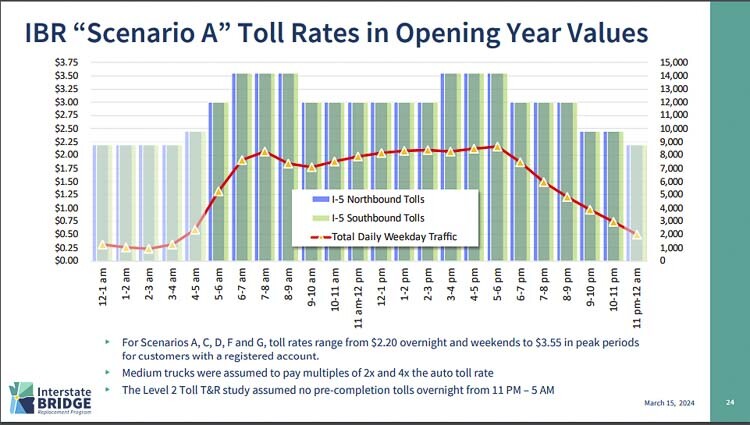New studies needed now that Oregon tolls canceled/paused
John Ley
for Clark County Today
Two Wasington and two Oregon members of the state transportation commissions met again to continue planning for Interstate Bridge Replacement tolls. The current finance plan for the $7.5 billion replacement includes “pre completion” tolls to begin in 2026. Eleven different toll scenarios are being evaluated by the subcommittee, in addition to a low income tolling program and tolls for freight haulers.
The Interstate Bridge Replacement Program (IBR) plans to raise between $1.2 billion and $1.5 billion via bonding toll revenues. The plan is to go to Wall Street in 2029 to borrow the money. “Tolling remains a key piece of how bridge replacement will be funded,” said IBR Program Administrator Greg Johnson following a surprise announcement of canceled tolling in Oregon.
Many citizens may have thought tolls were no longer allowed because Oregon Governor Tina Kotek “canceled” tolling. What she stopped was the implementation of “per mile” tolls, via their Regional Mobility Pricing Program (RMPP). Kotek allowed IBR tolls to continue.
The governor is asking the Oregon legislature to consider a major transportation tax package next year to pay for an estimated $3 billion funding shortfall the Oregon Department of Transportation (ODOT) faces. Some form of tolling could be a component of that package.
Initial IBR toll charges range from $1.50 to $3.55 per crossing, with higher prices when the bridge has more traffic. The evaluation expects an inflation rate of 2.15 percent a year. Seattle’s SR-99 tunnel toll has a 3 percent inflation rate adjustment every 3 years according to staff. That program is “underwater” for the life of the program and needs additional funds to bail it out.

Freight haulers would pay between 1.5 to 4 times the charges, depending on the scenario. Yet the Oregon Trucking Association (OTA) recently sued the state and governor because they have overpaid weight-mile fees based on usage and wear and tear on roads. Jana Jarvis, president of OTA, reminded the IBR’s Community Advisory Group of this reality during their meeting the day before.
Washington State Transportation Commissioner Jim Restucci mentioned that when tolling was implemented on SR-520 across Lake Washington, 30 percent of vehicles diverted to avoid the tolls. The staff only presented a diversion perspective based on Oregon’s I-205 tolling program (now on hold), and it was therefore irrelevant to the IBR discussion. Commissioner Roy Jennings believed they need a new study now that Oregon has canceled their tolling. He knows more people will divert to use a “free” I-205 instead of paying to use I-5.
Four of the eleven presented toll scenarios included the RMPP tolls which Kotek canceled earlier in the week. With no tolls now planned for I-205, Portland economist Joe Cortright estimates 30,000 vehicles will divert from using I-5 and overload the already crowded I-205. He believes half of future I-5 traffic will “disappear” with current 140,000 daily vehicles dropping to around 70,000 with tolls only on the Interstate Bridge.
“We really need to get a handle on a free I-205 versus a tolled I-5,” said Reema Griffith, executive director Washington State Transportation Commission. She asked when will an origination and destination study be done. There was no answer.
The base toll scenario would raise $1.24 billion according to the evaluation provided to the committee. Yet other options showed a 39 percent decline in revenue and a 9 percent traffic increase. It’s likely entirely new evaluations will need to be done now that the RMPP has been stopped and all the various studies included the prior Oregon plans for two sets of tolls in the region.
Citizen pushback was a key component of the Kotek decision. A February public opinion poll revealed 76 percent of Portland-area citizens are against tolling. Clackamas County citizens led the opposition as 91 percent did not favor tolling. Clark County citizens were not sampled. But with an estimated 75,000 or more citizens working in Oregon, the tolls are a huge concern for Southwest Washington residents.
Former Clark County Councilor Dick Rylander was the major force behind the council evaluation of both tolling and the IBR. “When I represented the Clark County Council in 2022 at the tolling commission we were told that the tolling was a done deal and moving forward,” he said. “We were told the committee’s job was to come up with ways to sell it to the public.
“Fast forward and it appears, for now, the tolls on 205 and 5 are on the backburner,” Rylander told Clark County Today. “So it is possible to stop the machine if enough people are loud enough for long enough.”
Other citizen comments submitted to the committee highlighted other problems with tolling. “A significant portion of each toll collected will go to building and servicing the toll program – not to the road projects,” said Tonja Dirkz of Portland. “There are less wasteful ways to tax us.” She noted the regressive nature of tolling and the negative impacts on neighborhoods due to traffic diversion to avoid paying the tolls.

Paul Cesmat of Springfield, Oregon said people already pay enough in gasoline taxes. “Isn’t
this project paid for by the federal government,” he asked. “Public roads should not be toll roads.”
Richard Cox believes “the vast majority of commuters would prefer a bridge with the simplicity and efficiency of the Glenn Jackson/I-205 structure. Spare us the additional expense.”
The committee was briefed on Oregon’s low income toll programs under consideration. Initially, two options were discussed with discounts offered for up to 400 percent of the Federal Poverty Level (FPL). One challenge is that low income discounts can increase the numbers of vehicles using the bridge or tolled road.
Today’s discussion featured discounts for people up to 200 percent of FPL, noting four programs from Los Angeles, San Francisco, Denver, and Hampton Roads, VA. Discounts ranged from a one-time $25 and a $100 credit, to a 50 percent discount, only for the first 10 toll trips a month. Enrollment rates were miniscule, from 0.7 percent to 2.8 percent of eligible people.
IBR staff shared two options, with a 50 percent discount preferred. They were “ambitious” in assuming a 44 percent enrollment rate. Jennings noted that any toll revenues “lost” with the discount program would need to be made up by charging higher toll rates for others. “If we give a discount, we have to come up with the money lost”, he said.
It was also revealed that it is likely a low income discount program would add to collection costs, as the Washington state program currently does not have such a program. The staff would have to negotiate with the WSDOT vendor for details and costs.
The full, two state transportation commissions expect to hold a joint, in person meeting in September. This is likely prior to a 3-state joint transportation commission meeting with California September 11-12.
Also read:
- Opinion: Hiding the growing cost of the Interstate Bridge replacementJoe Cortright of the City Observatory addresses the rising cost of the Interstate 5 Bridge replacement project.
- 90 minutes of delay on Southbound I-5 in Southwest Washington on Friday afternoon, July 26Travelers using southbound Interstate 5 through Woodland should expect up to 90 minutes of delay during Friday afternoon and evening and should delay travel or prepare for additional travel time.
- Nighttime paving work on I-5 and SR 14 in Clark County July 28-Aug. 9Nighttime travelers in Clark County should expect delays for maintenance and paving work beginning Sunday, July 28 until the morning of Friday, Aug. 9.
- Northeast 182nd Avenue/Northeast Ward Road to be closed on Aug. 1Northeast 182nd Avenue and Northeast 172nd Avenue in Clark County will have single-day closures on August 1 and August 5 for road preservation, with detours in place.
- Interstate Bridge Replacement program awarded $1.499 billion FHWA Bridge Investment Program grantInterstate Bridge Replacement program officials have shared that the program received $1.499 billion through the Federal Highway Administration’s Bridge Investment Program.









